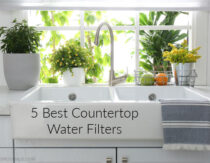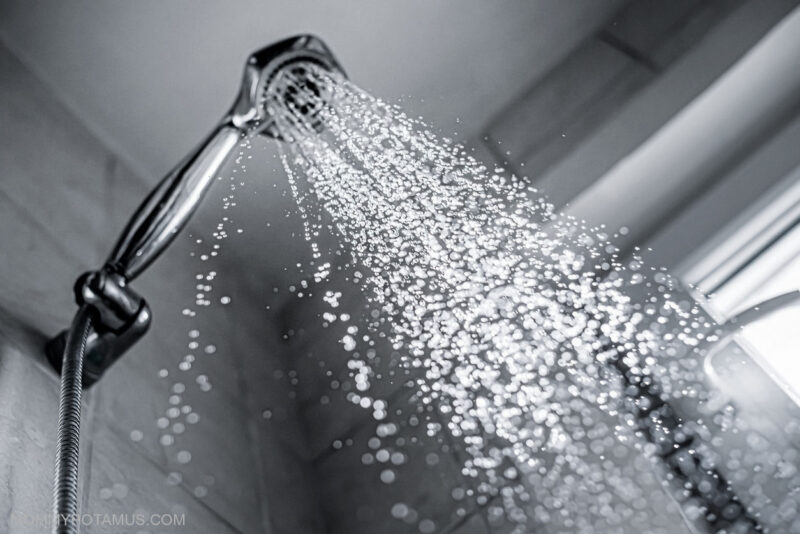
You know the amazing, fresh-and-clean feeling that comes with a good, hot shower . . . preferably one that includes my sudsy 3-ingredient body wash?
Nothing beats it . . . but knowing what may be growing in the shower head and/or vaporizing into the air might dampen the effect a little.
Fortunately, using a shower filter can help with both of those problems. We’ll dive into all the details below, plus my top filter recommendations.
- Why Use A Shower Filter?
- 1. Mycobacteria Can Grow In Shower Heads
- 2. Showers Vaporize Chlorine & VOCs Into Inhalable Gases
- 3. Hot Showers Increase Skin Absorption of Some Chemicals
- So, what are the benefits of using a shower filter?
- Types of Shower Filtering Materials
- Best Shower Filters
- Pelican/Pentair Premium Shower Filter
- HydroViv Shower Filter
- ProOne Shower Filter
- Aquasana Shower Filter
- Culligan WSH-C125 Wall-Mounted Filtered Shower Head
- Culligan HSH-C135 Hand-Held Filtered Massage Showerhead
- Sprite HKE-CM Biarritz 7-Setting Hand Held Filtered Shower Handle
- Other Shower Filters I Considered
- So, what’s the best shower filter?
- Do you have a question about shower filters?
Why Use A Shower Filter? ^
When most of us hear the words “water filter,” we think about drinking water. Since water makes up about 60% of our bodies and is essential for:
- Delivering oxygen throughout our bodies
- Supporting detoxification
- Lubricating joints
- Keeping skin supple
. . . and so much more, prioritizing safe drinking water definitely makes sense. However, the quality of the water we shower or bathe in also matters. Here’s why:
1. Mycobacteria Can Grow In Shower Heads ^
According to this study of 656 households across the United States and Europe, shower heads are often breeding grounds for bacteria that “can become aerosolized and inhaled when the shower is in use.” They’re also havens for biofilms, which is the gunk bacteria like to grow in.
The study found that the “genus Mycobacterium was consistently the most abundant genus of bacteria detected,” and is two times more likely to be found in homes receiving municipal water than well water. They add that:
While most of these bacteria are innocuous, some are potential pathogens, including members of the genus Mycobacterium that can cause nontuberculous mycobacterial (NTM) lung infection, an increasing threat to public health.”
The exact strain of mycobacteria differed based on region, water source, and water chemistry, but the researchers did note that certain “hot spot” areas where they found the more pathogenic strains of mycobacteria tended to overlap with regions where NTM lung disease is most prevalent.
It’s thought that chlorine disinfection likely plays a role in making shower heads hospitable environments for mycobacteria, which might be why it’s more prevalent in households that have municipal water instead of well water.
Shower filters may help by reducing chlorine by as much as 97%. That said, it’s a good idea to clean your shower head periodically whether or not a filter is present.
According to J.W. Plumbing, here’s the best way to clean your shower head:
First, you will fill a plastic bag with distilled white vinegar and wrap it around the showerhead securing the bag with a rubber band or the like. Let your it soak for three to 24 hours depending on how dirty it is and how much mineral buildup is present. Then remove the plastic bag and let all the residual vinegar drain out of the showerhead.
Next, you simply run fresh hot water through your showerhead to wash out any remaining vinegar, mineral deposits, and other debris.
PLEASE NOTE: If you have a brass, gold, or nickel-coated shower head, don’t leave it in the vinegar for more than 30 minutes; otherwise, it could damage the surface.”
They also note that you’ll want to clean the filter screen, which you can find instructions for here.
2. Showers Vaporize Chlorine & VOCs Into Inhalable Gases ^
Recently, showers have been suspected to be an important source of indoor exposure to volatile organic compounds (VOC’s)” – PubMed
As I covered in this article, chlorine is a powerful disinfectant that’s used to kill bacteria and harmful microorganisms, while chloramine is similar type of disinfectant that is made by mixing chlorine with ammonia.
Both create disinfection byproducts such as trihalomethanes – THMs for short. One THM – chloroform – is a known carcinogen, and there are several others that may increase cancer risk. (1) (2) (3)
When we shower – especially in warm or hot water – chemicals like chlorine, chloramine and chloroform tend to vaporize faster than the water itself, creating an environment of concentrated VOC gases that we absorb via our lungs. (4)
That’s a big deal, because while our detoxification organs can filter out some of the chlorine from our drinking water, the VOCs and other disinfection byproducts we inhale during showering or bathing enter directly into our bloodstream. (5)
In fact, research suggests that we absorb the same amount (or more) of chloroform from one 10-minute shower as we would from drinking two liters of tap water. (6) (7)
3. Hot Showers Increase Skin Absorption of Some Chemicals ^
Because warm water increases blood flow and opens up our pores, showering can cause a substantial increase in the absorption of chlorine/chloramine and disinfectant byproducts like trichloroethylene and chloroform. (4)
Some of these chemicals, particularly chlorine, strip natural oils from our skin and hair.
This can cause oxidative stress that leads to dry skin, dry or frizzy hair, and accelerated skin aging. (8)
Also, it makes sense that chemicals used to kill/reduce bacteria in our water may also have a negative impact on the beneficial microbes that live on our skin – aka our skin microbiome.
A balanced skin microbiome plays a role in skin resilience, resistance to unwanted pathogens, and more, so – just like with our gut microbiome – it’s probably wise to try to keep the good guys intact when possible. (9)
So, what are the benefits of using a shower filter? ^
The short answer is they significantly reduce our toxic burden (the amount of toxins we absorb on a daily basis) by improving the quality of the water we shower in.
As a bonus, they also help our skin and hair retain their natural protective oils, which improves softness while reducing hard water mineral buildup that can weigh hair down.
Types of Shower Filtering Materials ^
In some ways, hot water is a little more challenging to filter than cold, which makes the optimal ratio and type of materials used different than what you’ll find in countertop or under sink systems.
Activated Carbon – Also known as activated charcoal, this filtration medium contains millions of micropores that grab onto heavy metals, viruses, poisons, certain types of bacteria, and other substances. Just two grams of coconut-derived activated charcoal has a larger surface area than an entire football field. (10)
It’s affordable and sustainable, making it a great starting point for shower filtration. However, it doesn’t perform as well in hot water as it does cold, so it’s usually paired with materials that do better with heat.
KDF 55 – This blend of high purity copper and zinc granules is designed specifically to remove/reduce chlorine and water-soluble heavy metals. It helps controls scale, bacteria and algae, even in hot water.
Vitamin C – Also known as ascorbic acid, purified vitamin C reduces chlorine and chloramine exposure by neutralizing them. However, vitamin C cartridges tend to wear out quickly, so they often reduce the filter life to around 2-3 months.
Important Note: Although chlorine and chloramine are used to accomplish the same goal – water disinfection – you can’t use the same type of filter to remove both of them.
Some shower filters below can remove up to 97% of chlorine, but because of issues related to contact time (how long the water is exposed to the filtration materials) and heat, I am not aware of any filters that can achieve that removal rate for chloramines.
To find out if you need to filter chloramines, check your local water quality report or reach out to your water supplier and ask them what they use to disinfect.
If they use chloramine, there are a few options below that focus on reducing it along with chlorine. If you want to reduce a higher percentage of chloramines specifically, the best way to accomplish that is with a whole house filtration system.
Best Shower Filters ^
These shower filters significantly reduce chlorine and other contaminants from bathing water.
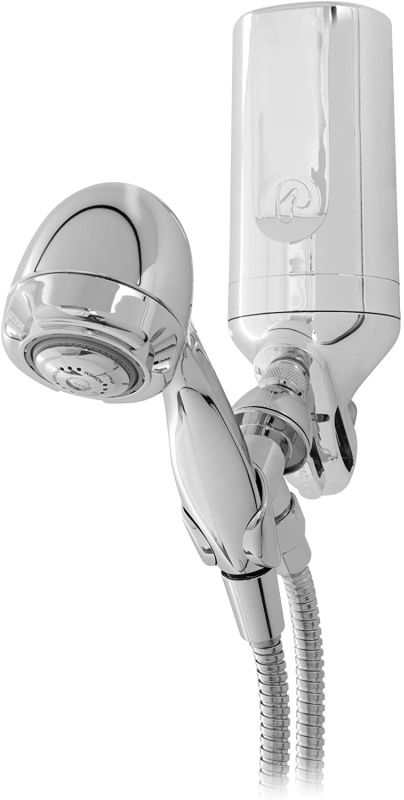
Pelican/Pentair Premium Shower Filter ^
Price: $52.62 – $70.20
Pelican makes several 3-stage shower filters with a detachable nozzle and/or a fixed nozzle in two different finishes (chrome and white). The model with the detachable nozzle comes with a massaging shower head and a tangle-free 5 foot cord. They also sell just the filter, which you can use with your own shower head if you’d like.
Each model meets NSF/ANSI Standard 177, which measures the reduction of free available chlorine. New filters will reduce more than 96% of chlorine in shower water, and tests show that the total dechlorination is still high at around 90 percent after 15,000 gallons have been filtered.
Pelican also says that their filter reduces chloramine, so I called and asked for more information on the actual removal rate. According to the customer service representative I spoke with, the Pelican can remove up to 96% of chloramine and some pharmaceuticals.
Filtration Technology Used
Here’s how Pelican describes their 3-stage filtration process:
“Stage 1 – Copper and Zinc Oxidation Media
Includes a patented blend of media used to filter chlorine and other contaminants from your shower water. Your hair and skin will enjoy the many benefits of dechlorinated water.
Stage 2 – GAC Carbon Media
Includes a special blend of steam activated carbon media. This media is designed to filter out chloramines and synthetic chemicals as well as unpleasant odors. Your water will now smell fresh and clean.
Stage 3 – Far Infrared Balls
Consists of Far-Infrared emitting volcanic media that induces reduced or negative ions into the water. This results in a lower surface tension in the water allowing for better hydration of hair and skin. Changing the surface tension in the water also makes the water feel softer on your hair and skin, leaving you with a feeling of having just left a spa.”
Pros
- Tested to NSF/ANSI Standard 177 to reduce more than 96% of chlorine in shower water. Tests show that the total dechlorination is still high at around 90 percent after 15,000 gallons have been filtered.
- Also reduces chloramines and other contaminants
- Comes with dual-flow shower head that switches between high-flow & water conservation spray settings (1.0 -1.5 gallons per minute depending on the setting for the fixed shower head, and 1.5 -2.5 gallons per minute for the detachable shower head)
- Filter doesn’t lower the height of the shower head (Some do, which can be a problem for tall people)
- Doesn’t impact perceived flow rate
- Filter life is 6-9 months
- Easy installation
- Fits a standard 1/2 inch shower pipe
- If desired, you can use your existing shower head as long as the connection is a standard 1/2 inch.
Cons
- Replacement filters cost about the same as a whole new unit, which is common for this category of filters. (They do cost less than the model with the detachable nozzle, though.)
- The water flow rate of the fixed shower head (1.0 to 1.5 GPM depending on the setting) is on the low side, but Pelican says it will not affect water pressure. The model that comes with a handheld has an excellent max flow rate of 2.5 GPM)
- Needs a minimum height of 6 1/4 inches above the shower pipe for installation.
My Take On The Pelican
There are A LOT of shower filters on the market, many of which only cost around $30. However, they’re often made by companies that don’t provide any independent testing or certification information to back up their claims.
Speaking of claims, NSF/ANSI testing methods for shower filters focus exclusively on chlorine removal, so companies tend to focus on this aspect because it can be verified. Many companies will tell you if their filter also removes other things like chloramine, but they’re less likely to mention percentages on their product descriptions because there’s no standardized testing method.
Pelican is well-respected for its ability to make quality systems that are relied on for whole house filtration, under sink filtration, and more. They’ve used their extensive knowledge to develop solid products that do what they say time and again, so I find their claims for shower filter contaminant removal to be reasonable even without standardized testing methods.
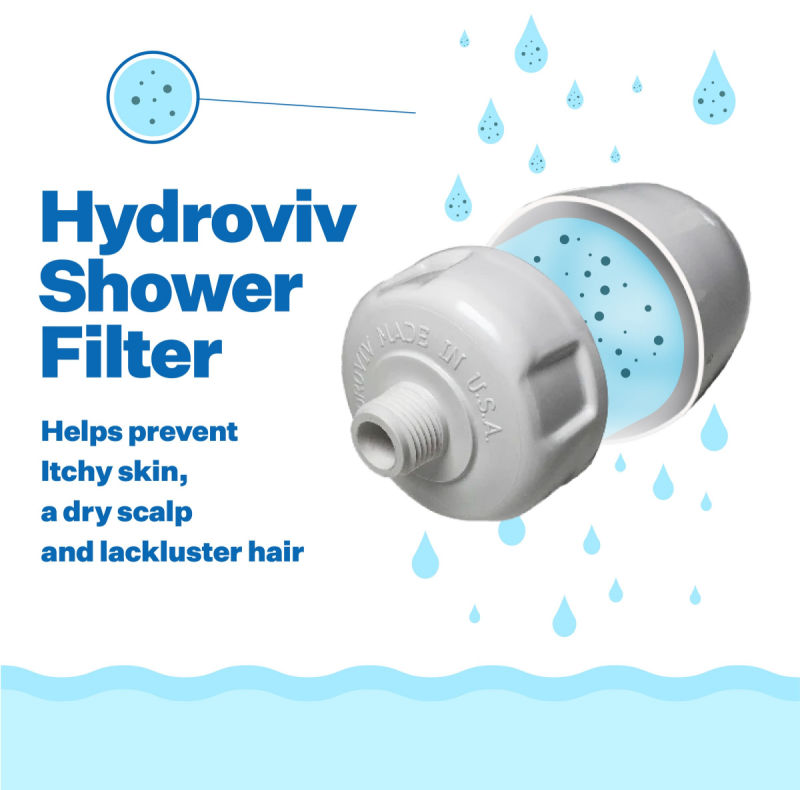
HydroViv Shower Filter ^
Price: $84.99
Unlike the HydroViv under sink filter, which is customized to address contaminants listed in your local water quality report, the HydroViv shower filter is a global formulation designed to focus on the types of chemicals that can be readily absorbed through the skin, irritate the skin, and/or can be inhaled.
Filtration Technology Used
- Catalytic carbon and KDF 55 (a copper-zinc blend) for chlorine and chloramines.
- Activated carbon blend for volatile compounds like disinfection byproducts and VOCs
- KDF 85 and activated carbon blend for sulfur and other stinky things
Pros
- Focuses on the types of chemicals that can be readily absorbed through the skin, irritate the skin, and/or can be inhaled
- Fits onto any shower head
- Installs in 5 minutes or less
- Filter cartridge lasts 6-9 months
- The inside the cartridge housing can be periodically cleaned with a damp cloth (they recommend this as part of regular maintenance)
Cons
- Replacement cartridges cost more than the original filter unless you set up autoship which saves you 25%
- Some people may not like the way it looks from an aesthetic perspective
My Take On The HydroViv
HydroViv doesn’t list a certain number of contaminants removed due to what they see as a lack of standardization for shower filter testing. However, the do say that their filters remove 78-97% of chlorine and chloramines, plus 75-96% of volatile compounds like disinfection byproducts and VOCs.
They use some of the most effective hot water filtration materials available (KDF 55 and 85), so I’m inclined to believe them when they say they’ve optimized their shower filter – based on toxicological research – to filter chemicals that pose a risk from skin contact/inhalation.
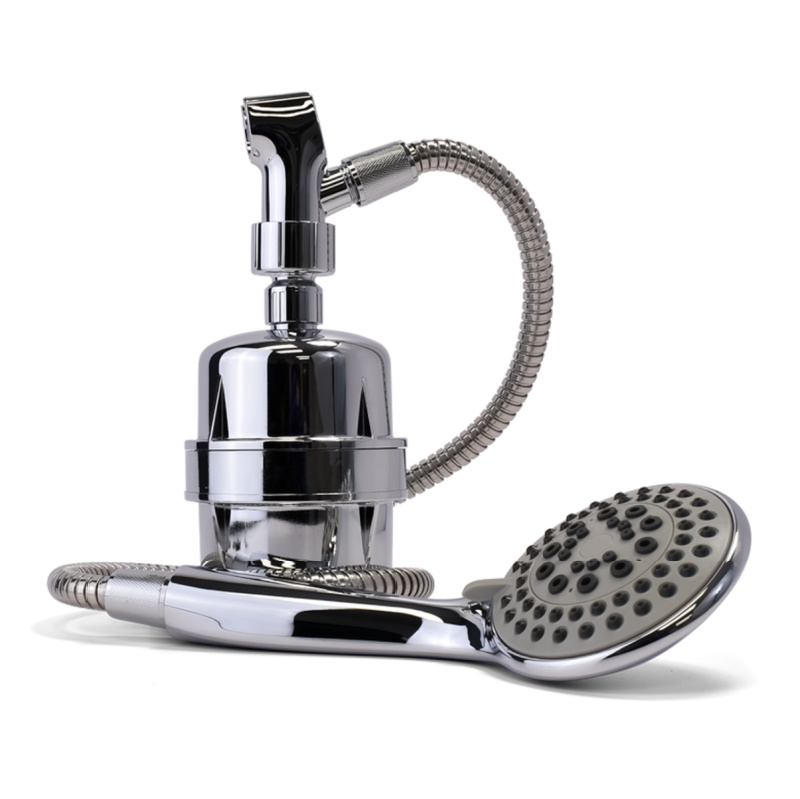
ProOne Shower Filter ^
Price: $79.95 – $99.94 depending on the model
ProOne makes shower filters with a detachable nozzle and/or a fixed nozzle in three different finishes (chrome, brushed nickel and antique bronze). Each model comes with a 5 function massaging shower head for a more relaxing shower experience.
The ProOne shower filter has been tested to reduce 200+ contaminants including VOC’s, heavy metals, lead, pesticides, chloramines, chlorine, fluoride, herbicides and pharmaceuticals.
Remember, there is no standard testing developed for shower filters beyond chlorine removal, so this test may not be the same one used if they ever expand the number of contaminants considered. Still, it’s valuable information in my opinion, and they posted a link to the lab results on the product page.
Filtration Technology Used
According to the manufacturer, the filters use a “new ProMax™ encapsulated multi-stage filter cartridge technology. Each stage is comprised of a unique proprietary formula of filtration media designed to target a specific group of contaminants. Helps protect your skin and hair from unhealthy effects of contaminants that may be in your water.”
Because it’s proprietary the exact composition is not available, but according to ProOne “Each stage consists of Granulated Activated Carbon infused into microstructure filtration media.”
Pros
- Comes in a variety of finishes that blend well with home decor
- Tested by a certified independent lab to NSF/ANSI Standards 42, 53, P231, and P473
- 5 function massaging showerhead
- Easy to install (Made universal to fit 1/2” NPT, ISP, and BSPT pipe thread standards. Includes a roll of Teflon tape)
- Filter lasts up to 6 months with everyday use
- Good flow rate of 2 gallons per minute (GPM)
Cons
- While it reduces a broad range of contaminants, it doesn’t remove as much chlorine as some other models (For example, it reduces up to 57% while the Pelican model below reduces over 96%. It does remove up to 71% of chloramines, though.)
- Filter is longer than some others, which lowers the height of the shower head. May be a problem for some tall people.
- Some models not currently in stock
My Take On The ProOne Shower Filter
This is one of my favorites in terms of style, and it filters a wide range of contaminants. I’d love to see the addition of KDF 55 media to increase the amount of chlorine removed.
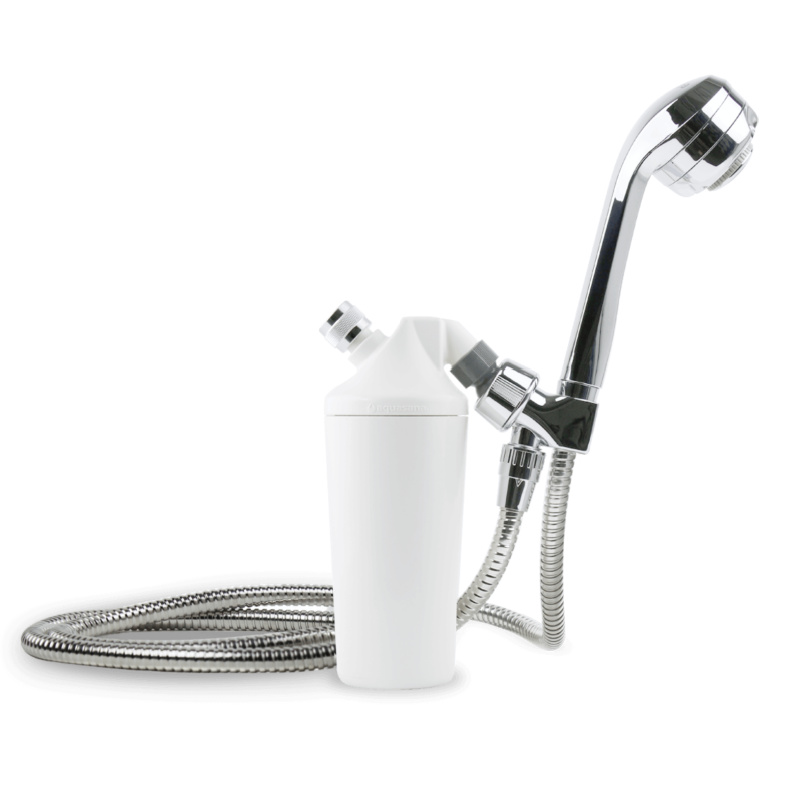
Aquasana Shower Filter ^
Price: $59.99 – $69.99
Aquasana makes a fixed shower filter and one with a handheld wand in two different finishes – white and chrome. They use a unique design that increases water contact time – aka the amount of time the filtration materials have to actually pull stuff out of the water – which leads to an increase in filtration performance.
Filtration Technology Used
Aquasana shower filters use coconut shell carbon to filter out chlorine and other harmful chemicals, plus a copper-zinc media to further reduce chlorine and help balance water pH.
Because Aquasana only lists “harmful chemicals” on their site in addition to chlorine removal, I called to get a little more information. For municipal water, the filtration materials are designed to remove heavy metals, pesticides, herbicides, some pharmaceuticals, and “forever chemicals” such as PFAS, which is a contaminant that doesn’t break down and therefore bioaccumulates in our bodies.
The standard filter doesn’t target chloramine, but if you call them they can adjust the filtration media in your specific filter to do that. They can also optimize for well water if needed.
Pros
- Tested to NSF/ANSI Standard 177 to reduce more than 90% of chlorine in shower water.
- Water flow rate is 2.5 gallons per minute which prevents a noticeable drop in water pressure.
- Filter lasts up to 6 months with everyday use
- Filter doesn’t lower the height of the shower head
- Easy to install
- Fits a standard 1/2 inch shower pipe
- Can be adjusted to target chloramine if needed
Cons
- Filter nozzle may be too short to accommodate larger shower heads
- Replacement filters cost nearly as much as the original filter, but you can subscribe to receive a 15% discount + free shipping
My Take On The Aquasana Shower Filter
Aquasana shower filters are consistently rated among the best in the industry, and for good reason. They use high-quality filtration materials and a unique design that increases the amount of time those filtration materials have to pull stuff out of the water.
They’ve used their extensive knowledge gained by developing countertop, under sink and whole house systems to develop a shower filter that works well under high-heat conditions with a rapid flow rate.
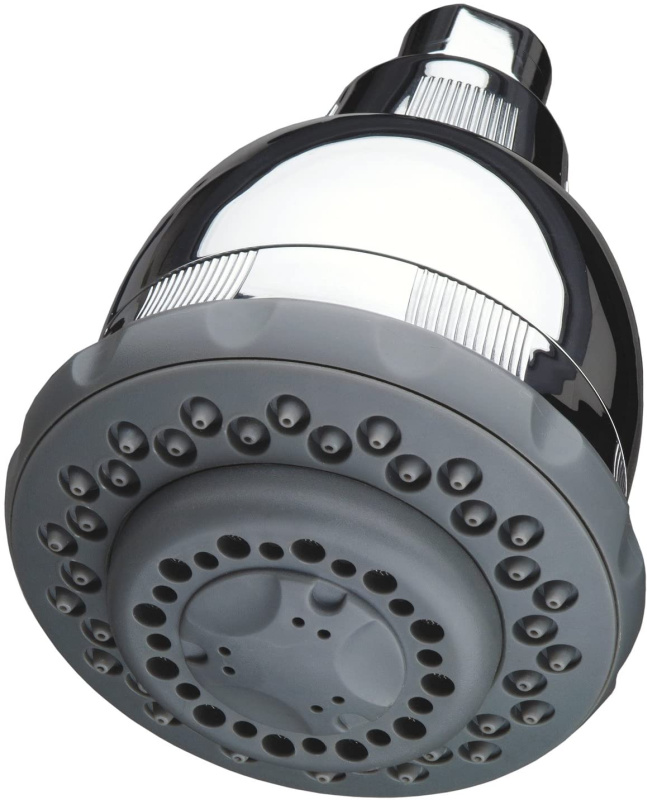
Culligan WSH-C125 Wall-Mounted Filtered Shower Head ^
Price: $40.78
If you’re looking for a filter that just removes the basics like chlorine, scale, rust and sulfur odor, the Culligan WSH-C125 is affordable and effective. It is tested and certified by The International Association of Plumbing and Mechanical Officials (IAPMO) to meet NSF/ANSI standard 177 for chlorine removal.
Also, unlike most of the filters on this list that remove contaminants before the water reaches the showerhead, the Culligan is actually a showerhead with the filtration materials built into it. As I mentioned earlier, shower heads are vulnerable to mycobacteria growth and typically need to be cleaned, but this particular shower head is unique because it contains bacteriostatic materials that limit passage and growth of bacteria.
Filtration Technology Used
Culligan doesn’t say on their product page what materials they use, but based on the information posted by retail shops that carry their products I think it’s KDF media. I’ve reached out fo confirm that and will update this article when I hear back.
Pros
- Tested and certified by IAPMO to meet NSF/ANSI standard 177
- Replacement filters are only about $20
- Long filter life of up to 10,000 gallons or 6 months
- Easy installation (Teflon tape included)
- Fits a standard 1/2 inch shower pipe
Cons
- Doesn’t remove as wide a range of contaminants as other filters on this list (For example, chloramine)
- May affect water pressure slightly
- Only one color option available
My Take On The Culligan WSH-C125
This is a good basic filter that stands out because it’s been independently certified to deliver on its claims for chlorine removal.
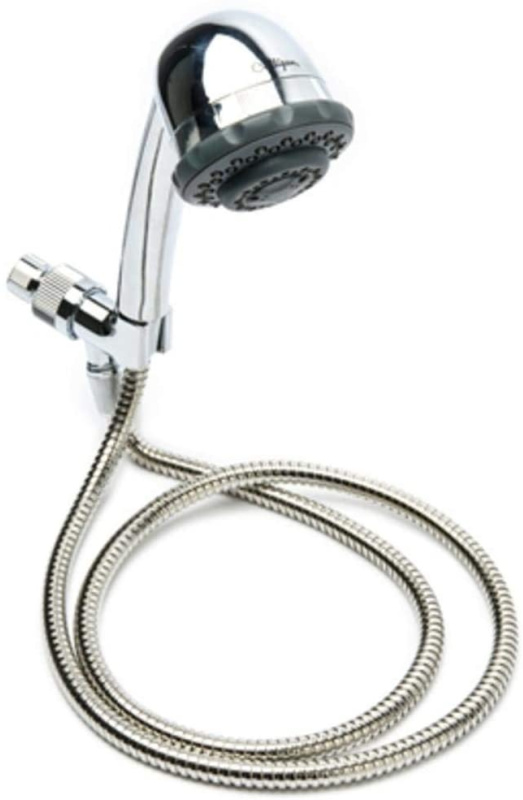
Culligan HSH-C135 Hand-Held Filtered Massage Showerhead ^
This model uses the same shower head filter we just discussed (with all the same pros and cons), but it’s a detachable shower wand instead of a fixed shower head.
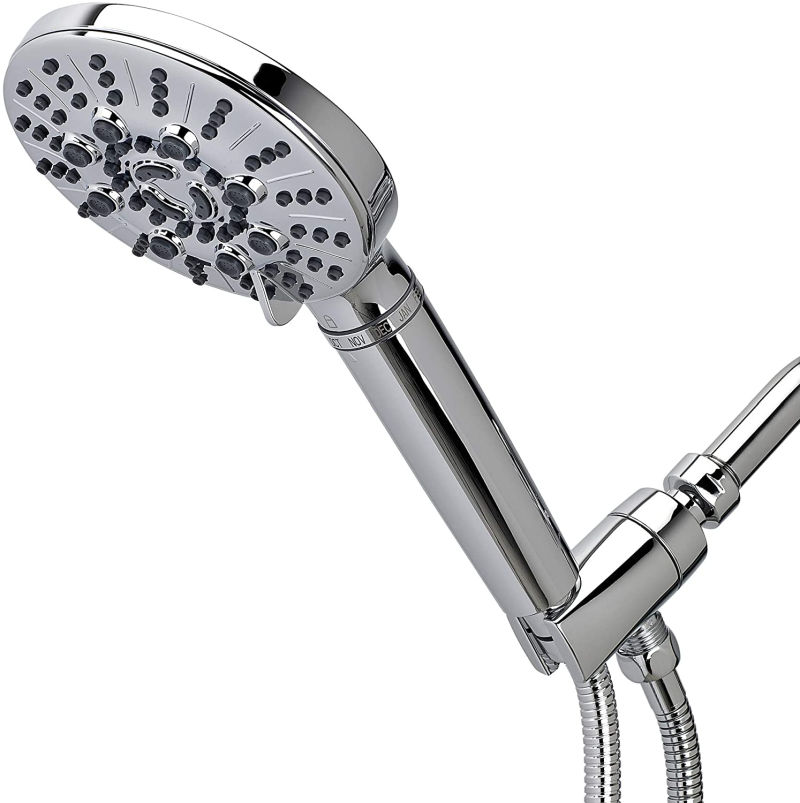
Sprite HKE-CM Biarritz 7-Setting Hand Held Filtered Shower Handle ^
Price: $69.29
Like the Culligan filters above, the Sprite HKE-CM Biarritz 7-Setting Hand Held Filtered Shower Handle is a basic shower filter that is certified to meet NSF/ANSI standard 177 for chlorine removal.
Filtration Technology Used
The Sprite uses Chlorgon filtration, which is a proprietary blend of Copper, Zinc and Calcium Sulfide.
Pros
- Replacement filters are inexpensive, $14.99 for 2-pack
- Certified to meet NSF/ANSI standard 177
- Shower head comes with 7 settings
- Easy Installation
- Built-in-filter replacement reminder -Comes withDial-A-Date filter replacement indicator or you can download the free Sprite Showers mobile app to track filter life and register warranty
Cons
- Doesn’t remove as wide a range of contaminants as other filters on this list (For example, chloramine)
- Filter life is only 3 months or 5,000 gallons, so you’ll need to change them more often
- Teflon tape not included
My Take on Sprite
I consider Sprite to be similar in performance to Culligan, but with a little more style.
Other Shower Filters I Considered ^
Any time I publish a review of several products at once, I get asked if I’ve considered a different brand. There are so many shower filters on the market it’s impossible to list them all in this article, but here are some popular options that I considered:
AquaHomeGroup Shower Filter – Popular on Amazon, this filter looks promising based on the description, but the company doesn’t provide any independent lab tests or certifications to back up its claims.
AquaBliss High Output Revitalizing Shower Filter – Also popular on Amazon, this one does not appear to be independently tested or certified and there are some complaints regarding the filter clogging and not living up to its claims.
If you think there’s another one I should please let me know in the comments!
So, what’s the best shower filter? ^
In my opinion all of the options above are good shower filters, which is why they’re on the list. Some have slightly different pros and cons, so the best way to choose one is to decide which objectives are a priority to you.
Here are my “best of” options for different goals:
Best Filters To Remove Chloramine – Pelican (up to 96%) or HydroViv, ProOne, and also Aquasana if you call them and ask them to customize your filter.
Best “Beyond Basic” Filters – For a filter that does a great job with chlorine removal but also grabs onto other heavy duty contaminants, consider the Pelican, HydroViv, or Aquasana.
Looking for a detachable shower wand? Check out the Pelican, ProOne, Aquasana, Culligan, or Sprite.
Most Affordable – Consider Culligan.
Widest Range of Contaminants Removed – Based on manufacturer info provided that would be ProOne, but remember it only reduces up to 57% of chlorine.
Optimized To Remove Contaminants That Are Specifically An Issue For Inhalation & Skin Absorption – Hydroviv
Do you have a question about shower filters? ^
Please let me know in the comments below!
Want more research-backed natural remedies?
No problem, I’ve created a free ebook for you – Kitchen Apothecary: 25+ Natural Remedies Using Ingredients From Your Pantry – as a gift for signing up for my newsletter. You’ll also get updates when I post about safe essential oils for pregnant/breastfeeding mamas, exclusive gifts and coupons (I was able to give away a jar of free coconut oil to anyone who wanted it recently!), plus other goodies.
Sign up using the form below.

Sources
1. Zierler, S. et. al. (1988) Bladder cancer in Massachusetts related to chlorinated and chloraminated drinking water: a case-control study
2. National Institutes of Health Division of Cancer Epidemiology & Genetics. Drinking Water Contaminants
3. Massachusetts Department of Environmental Protection (2018) TTHM in Drinking Water: Information for Consumers
4. Connecticut Department of Public Health. Proposed Revision to MCL for TCE
5. Canadian Centre for Occupational Health and Safety. How Workplace Chemicals Enter The Body
6. Jo, W.K. et. al. (1990) Chloroform exposure and the health risk associated with multiple uses of chlorinated tap water
7. Clifford P. Weisel and Wan-Kuen Jo (1996) Ingestion, Inhalation, and Dermal Exposures to Chloroform and Trichloroethene from Tap Water
8. Children’s Skin Center: Pediatric & Adult Dermatology (2019) The Effects of Chlorine On Your Skin
9. Byrd, Allyson L. et. al. (2018) The human skin microbiome
10. Dillon et. al. (1989) Large surface area activated charcoal and the inhibition of aspirin absorption.



